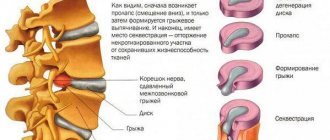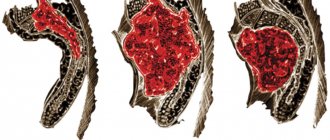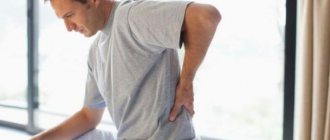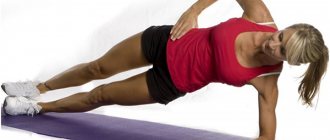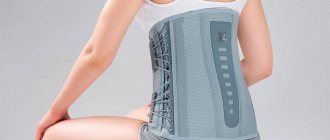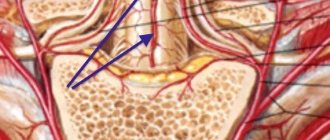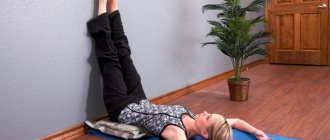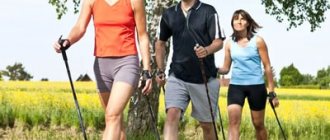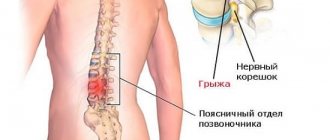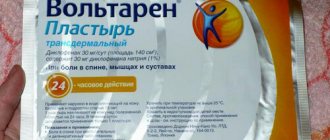Important! Patients diagnosed with a herniated disc should consult a specialist before starting sports to determine the cause of the pain and receive appropriate recommendations. Don't self-medicate!
Hernias vary depending on the part of the spine where they are located. There are hernias of the lumbar, thoracic and cervical spine.
In the conservative treatment of intervertebral hernia, it is important to know the localization of the pathology in order to accurately determine which techniques and to what extent should be used.
What is Schmorl's hernia?
Initially, this term was used exclusively as a radiological sign. It was Dr. Georg Schmorl who first described what Schmorl's hernias are. Obviously, the disease got its name from the doctor’s surname. Over time, pathology was included in the classification of spinal diseases. In KB-10 it was given the designation M54.1.
So, Schmorl's hernia, what is it? Having an X-ray before your eyes, it shows how part of the intervertebral disc protrudes into the body of the adjacent vertebra. In this case, compression of the nerve roots, nearby vessels and the spinal cord does not occur.
Typically, Schmorl's hernia is hereditary in nature and is first diagnosed in childhood, when rapid growth of the skeleton and the entire body occurs. Less often, it manifests itself in a more mature period (after 45 years), when the phenomena of osteoporosis begin. In most cases, the nodule is localized in the thoracic or lumbar regions.
Classes during the recovery period
The main part of therapeutic exercises to eliminate a hernia of the thoracic spine is carried out during the period of remission. At this stage, it is important to choose the right set of exercises. This should be done by a physical therapy instructor, taking into account all the characteristics of the patient. He will also determine how often you need to train to achieve lasting results. If all recommendations are followed, the patient will get rid of the manifestations of painful pathology without surgical intervention.
A set of “active” exercises
- Sit on a chair that has a wide back. Keeping your back straight, press it against the chair. Place your hands around the back of your head, clasping your fingers together. Bend towards your knees until you feel tension in your spine. Straighten up. Repeat the movement 8-10 times. The feeling of tension (not pain!) indicates that you are doing everything correctly: the muscles connecting the vertebrae have “started” to work. Strengthening this muscle group will prevent the vertebrae and intervertebral discs from shifting.
- Get down on the floor, lie down on a hard and flat surface. Place a cushion under your lower back. You can make it from scrap materials: towels or sheets. Place your hands behind your head. Arch your back as you inhale. Then exhale and relax. Alternating “flexion and extension” movements, carefully monitor the breathing system. This is an important aspect of the exercise, since during successive inhalations and exhalations the spine intensively bends, the work of the muscles in the intercostal space is stimulated, and the extensor section of the spinal muscle tissue is strengthened. The exercise is performed until muscle tension begins to be felt. If pain occurs, immediately stop performing the movement.
- Sit on the floor with your knees tucked in so that your buttocks are close to your feet. Wrap your arms around your knees as if you want to hug. Sway slowly, without haste, bending your back back and forth. Repeat the movements at least 10 times until you feel tension in the muscle tissue of the spine.
- Lie on your stomach. Please note that the surface on which you perform the exercise must be hard. Wrap your arms around your legs with your knees bent. Raise your head and legs at the same time. Do not try to bend as much as possible: it is difficult even for a healthy person to do this. Your task is to bend your body so that it resembles a “boat”. 3-5 seconds of tension are enough to achieve the desired effect. Relax and unwind. Perform 5 more approaches.
- Stand with your feet slightly apart. Raise your arms up, clasping your wrist with one hand and the other. Lean to the side, extending your arm. When performing the movement correctly, you should feel tension in your pectoral muscles. Change the position of your arms, bending in the other direction. In each direction you need to bend 8-10 times.
Never start training by performing complex and active exercises. The main rule of exercise therapy is a consistent increase in load. Monitor your condition after each exercise. If necessary, reduce the load or stop training.
Causes of hernia development
Schmorl's hernias in the lumbar spine and other areas can appear for a number of reasons that contribute to a decrease in the density of the bone tissue of the vertebrae. Often the disease has genetic background and occurs due to a discrepancy in the growth rate of bones and cartilaginous structures. The first lags behind in its formation, as a result of which zones of rarefaction and emptiness are formed in it.
In addition, the vertebral endplates are weak and break easily. If a person has had a spinal injury or has suddenly lifted a large load from the floor, as a result of a microfracture of these plates, the contents of the intervertebral disc prolapse. Making the situation worse:
- repeated microtraumas;
- increased loads on the spine when engaging in heavy and intense sports (diving, bodybuilding, etc.);
- lack of calcium and vitamin D in the body (osteomalacia);
- pathology of the parathyroid glands;
- degenerative age-related changes, osteoporosis;
- disruption of the innervation and blood supply to the spine for various reasons (sedentary lifestyle, metabolic changes in the body, etc.).
In women, Schmorl's hernia can progress during pregnancy.
Is it possible to cure a herniated disc without surgery?
Yes, but there are nuances here. “A spinal disc herniation can decrease and sometimes completely disappear with a well-chosen system of multicomponent rehabilitation, but this will take from a year to two to three years,” says Alexander Kolesov. “Treatment should be carried out under the regular supervision of a rehabilitation specialist using techniques such as physical therapy, physiotherapy (one of the new techniques is magnetic resonance therapy), gentle techniques of manual therapy and osteopathy, acupuncture, classes using the Neurak method and some others.”
In any case, treating a hernia is a rather lengthy process, so you should not expect instant results. However, with the right attitude and methodical training, you will most likely succeed.
Symptoms of the disease
As a rule, Schmorl's hernia has a latent course, without obvious clinical manifestations. Symptoms begin to appear only in the later stages of the disease or when complications occur. Large nodules over time negatively affect the flexibility and mobility of the spine, leading to its curvature. Due to excessive load on the joints connecting the processes of the vertebrae, spondyloarthrosis occurs.
In the lumbar spine
In advanced cases, Schmorl's hernia of the lumbar spine can manifest itself with pain, loss of sensitivity and limitation of motor activity in the lower extremities. Lordosis is formed. A person may feel fatigue and discomfort in the lower back, especially after vertical loads.
In the thoracic region
In the later stages of development, Schmorl's hernia of the thoracic spine is manifested by the following symptoms:
- fatigue, discomfort, heaviness in the back;
- painful attacks such as intercostal neuralgia or myofascial syndrome of paravertebral muscles;
- the appearance of curvature of the spine (kyphosis).
Signs of the disease manifest themselves more clearly in an upright position of the body, practically disappearing if the person lies down.
In the cervical spine
A severe Schmorl's hernia of the cervical spine disrupts the blood supply and innervation of the disc, which can result in headaches, nausea, vomiting and general malaise. Vertebral artery syndrome often develops. High risk of stroke.
Multiple Schmorl's hernias
If there are many nodules, the symptoms will be more pronounced and varied. With multiple lesions, curvature of the spine and chronic pain syndrome are almost always observed.
Symptoms and pain in the thoracic region
Pain syndrome is noted by 99%, and it is this that first forces people to seek help from a medical facility. In the initial stages, people rarely pay attention to such early manifestations of the disease as:
- increased fatigue of the spinal muscles;
- slight tightness in the chest area;
- slight tingling when turning;
- minor and short-term pain in the middle of the back, in the ribs during prolonged standing, sitting, after sleep, physical activity.
As the disease progresses, the symptoms and signs of pain become more distinct, more persistent, and more difficult to bear. In addition, they are able to masquerade as completely different pathologies, which can mislead both patients and doctors.
Due to the very similar clinical picture, vertebrogenic thoracalgia is often mistaken, for example, for angina pectoris, gastric ulcers and gastritis, pancreatitis, appendicitis, pyelonephritis, cholecystitis, pneumonia, etc. Special techniques and principles of differential diagnosis help doctors reliably distinguish one disease from another.
Let us list all the symptomatic phenomena typical of herniated intervertebral discs along the thoracic vertebral axis:
- shooting, aching, stabbing or dull pain in the chest (left, right, middle), between the shoulder blades, from the shoulder blades and below, at the top of the peritoneum;
- girdling, piercing pain in the sternum, intensifying when trying to take a deep breath, turn around, cough (shortness of breath is possible);
- all kinds of paresthesias (tingling, crawling, numbness, etc.) in the chest, back, arms and hands, in the upper part of the abdominal cavity;
- tension of the spinal muscles, limited range of motion in the back, forced change in posture due to painful discomfort (stooping, etc.);
- difficulty swallowing, breathing;
- muscle weakness in the upper and/or lower extremities, worsening gait;
- complete or partial loss of sensation in the lower half of the body, most often in the legs, in the perineum and groin, genitals, and lower abdomen;
- in advanced cases, urinary/fecal incontinence, impotence, frigidity, infertility.
If disc prolapse is concentrated in the upper Th segments (1-2, 2-3, 3-4), and it affects the spinal cord, it can completely paralyze the entire body except the head. Fortunately, the upper segments are extremely rarely affected.
In some cases, a disc herniation actually causes a malfunction of individual internal organs. Quite often it provokes a violation of carbohydrate metabolism, inhibition of enzyme secretion or depletion of the hormonal apparatus (mainly insular) of the pancreas. Against the background of enzymatic deficiency and hormonal insolvency, dyspepsia, dyskinesia of the stomach and intestines, endocrine pathologies, etc. develop.
Diagnostics
Schmorl's hernia in the lumbar region and other anatomical areas of the spine is clearly visible on an x-ray. Radiography is the main method for diagnosing this pathology. In the absence of active complaints, the doctor may suspect the development of a nodule if the patient has a pronounced change in posture or curvature of the spine. The presence of blood relatives with a similar problem and a history of microtrauma will also speak in favor of this diagnosis.
If an intervertebral hernia is suspected, an MRI or CT scan may be additionally prescribed. To determine the reasons contributing to the appearance of Schmorl's nodules, the patient may be referred for a comprehensive examination.
Treatment of Schmorl's hernia
Schmorl's hernia, what is it and how to treat it? When answering this question, the doctor always focuses on the fact that the complex of treatment measures is prescribed individually for each person. If the nodule in the spine is single and small in size, it is recommended to observe it and follow all medical instructions (lead a healthy lifestyle, with adequate physical activity and good nutrition, undergo periodic check-ups).
For large and/or multiple Schmorl hernias, conservative therapy is prescribed. It pursues the following goals:
- improve the metabolism of bone and cartilage structures of the spine;
- provide the body with calcium and other microelements and vitamins;
- reduce the load on the vertebrae, eliminate all negative factors that contribute to the progression of the process.
If the pathology has led to complications such as intervertebral hernia or compression fracture, surgical treatment is indicated.
Surgical treatment
For uncomplicated Schmorl's hernias, operations are not performed. In severe cases, percutaneous puncture vertebroplasty, laser vaporization, or radical disc replacement with an implant are often performed.
Drug therapy
Drug therapy is symptomatic. It is based on groups of drugs:
- local agents with analgesic and anti-inflammatory effects;
- chondroprotectors;
- muscle relaxants;
- vitamin and mineral complexes;
- medications that improve bone tissue trophism.
The treatment regimen is selected by the doctor.
Therapeutic gymnastics and physical education
Standard treatment for Schmorl's hernia always includes exercise therapy. The exercises are selected by a specialist, taking into account the characteristics of the patient and the existing pathology. Regular training strengthens the muscle frame and relieves tension from the spine.
Massage
If there is a Schmorl's hernia in the spine, massage helps relieve unpleasant symptoms and alleviate the patient's condition. At the same time, the passage of blood and lymph through the vessels improves, and normal metabolism is restored.
Gymnastics by Dikul and Bubnovsky for hernias
Since the causes of back pain are very diverse, it would be wrong to say that any general exercises for a herniated disc can solve the problem. In each specific case, first, it is necessary to establish the specific cause that causes the pain, and then select a set of exercises for a herniated spine that will help, if not eliminate it completely, then reduce the pain.
According to user reviews, the most well-proven ones are gymnastics S.M. Bubnovsky and gymnastics by V. Dikul. However, you should not think that the sets of exercises developed by these specialists, which you prescribed to yourself, will be able to cure you. Remember, a hernia is not the cause of back pain! There is no need to try to treat a hernia with exercises - they can only help strengthen the muscle corset and rehabilitation during the treatment process.
If you are impressed by the treatment method of S. Bubnovsky or V. Dikul, consult a specialist doctor at the appropriate center. Only in this way can you find out what exercises, in what quantity and in what sequence you need to perform in order to eliminate the cause of back pain. Any gymnastics from the Internet can, at best, relieve symptoms, but not solve the problem!
Prevention of Schmorl's hernia
It is important to know not only the symptoms and treatment of Schmorl’s hernia in the thoracic spine and its other areas, but also to follow preventive measures:
- do not lift heavy objects;
- minimize the vertical load on the spine;
- control body weight.
Compliance with the canons of a healthy lifestyle and therapeutic exercises will help prevent the development of this disease.
Complications and consequences of thoracic hernia
What happens if you don’t treat a Th hernia or try to treat it, but incorrectly? Every sane person should understand that this will not end well. The patient risks losing the most valuable thing in his life in a short period of time - the ability to move. Poor quality treatment and its absence ultimately lead to extremely serious complications, leading among them:
- intercostal neuralgia (thoracic radiculitis);
- compression damage to the spinal cord, since the thoracic region has a very small intravertebral space;
- paresis, paralysis of arms and/or legs;
- immobilization of the entire half of the body, below the affected disc, or from the neck to the legs;
- failure of the functioning of the pelvic organs;
- critical dysfunction of the cardiovascular system and respiratory organs;
- progression of orthopedic disorders (scoliosis, kyphosis, dysplasia, etc.);
- active provocation of herniation at completely different levels of the spine.
Lesions in the chest area are one of the insidious consequences that can easily make a person disabled and incapable of self-care. The prognostic factor for a successful outcome is early diagnosis and correctly selected treatment tactics.
